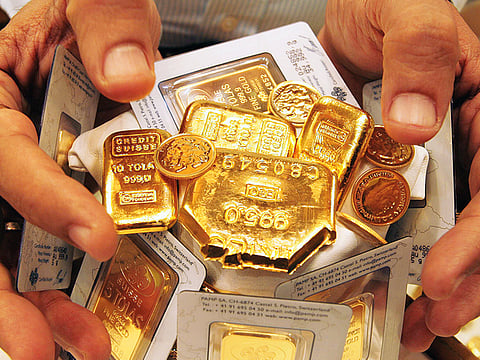Is it the right time to invest in gold?
Gold prices have been trading in the range of $1,100-$1,400 an ounce since 2013

Dubai: Gold is looking attractive again after years of underperformance.
Gold prices have been trading in the range of $1,100-$1,400 (Dh4,037-Dh5,138) an ounce since 2013, after hitting the levels of more than $1,800 in 2011. On Thursday, international spot gold was at $1,319.13. Going forward, the macro theme of higher inflation and interest rates is expected to continue and that would provide underlying support for gold.
“One of my favourite charts is gold, and the negative reaction that we have seen in metals have always occurred ahead of the event. The 5 rate hikes in the cycle we had in this cycle they all led to gold weakness ahead, only for gold to rally strongly afterwards,” Ole Hansen, head of commodity strategy at Saxo Bank told Gulf News during his field visit.
Higher inflation and interest rates have been always supportive of the yellow metal, which is often seen as a hedge against any increase in the consumer price index.
“Rate hikes has been the best buying opportunity for gold during the past 2 years, since the present cycle has been ongoing. So long as we don’t see any accelerated cycle of rate hikes in the US, gold is going to perform reasonably well. We are buying gold as a hedge against inflation, geopolitical uncertainty, against worries about stocks markets, and all these drivers are still there,” Hansen said.
Saxo Bank said the level of $1,375 has been a strong resistance for gold, which was rejected 3-4 times.
“The correction is quiet shallow and we have been holding the level of $1,300. If we break above $1,385, we will see a level of more than $1,485,” Hansen said.
Urge
“There has not been a strong urge to invest in gold as stock markets have been doing well, along with very low interest rates that central banks have been trying to support. But those are now starting to unravel. We are seeing signs of increased volatility in stock markets, and that is also helping to reignite the focus on gold. Gold prices have been stuck in a range for many years. The need for gold for diversification has started to emerge in the past year,” Hansen said.
The Bloomberg Commodity index, the Goldman Sachs commodity index and the Deutsche Bank optimum yield index has seen biggest interest this year. There has been an inflow of $600-700 million in the first 6 weeks into these funds.
“If we look at investment flows so far this year, for the first time in many years, money is flowing into broad based commodities indices. The ETF [Exchange Traded funds] comes with the whole spectre, that indicates the diversification aspects as they move from potentially higher inflation or interest rates scenario,” Hansen said.
The money is going into precious metals through ETF. For instance, about $825 million flowed into gold ETF compared to an outflow of $1.59 billon from energy and $1.2 billion in broad based commodities.
“The increased allocation that we have witnessed over the past few years in ETFs as a safe haven or diversifier has been increasing and that won’t go away anytime soon,” Hansen said.
“If the US overheats, and that would lead to worries about disinflation or deflation, we would see a bigger correction in stock markets, and that would have a positive impact on gold,” he added.
Other precious metals
Silver has underperformed compared to its rich cousin — gold.
Over the past five years, silver prices have lost 42 per cent in value compared to a 17 per cent loss in gold.
“What has been disappointing is something like silver. Silver is probably a commodity that has softened. Silver has lost its value against gold despite the metal’s rally in the past year,” Hansen said.
Silver is more or less trading close to the cheapest level in the past 20 years relative to gold, and the per ounce level is 18.
Hansen is also bullish on palladium but the small size of the market is a put off.
“Palladium is in short supply, but its too small a market to get involved in for most people. It has a strong fundamental story,” Hansen said.
Sign up for the Daily Briefing
Get the latest news and updates straight to your inbox


